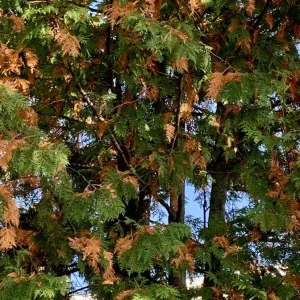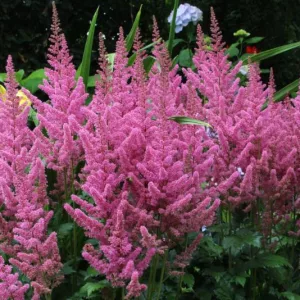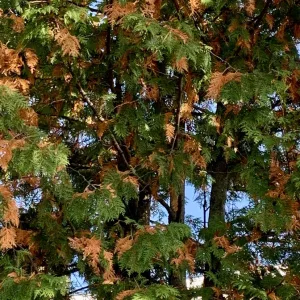Summary
Gardening expert, Susan Richards, offers some insight about why some evergreen foliage turns yellow in the fall.
Fall is an amazing time of year in our gardens! Although I always feel sad that the gardening season is ending, I revel in the sight of all the amazing fall flower and leaf colours. My autumn sedum flowers have matured to a deep rose/burgundy; the seed heads on my ornamental grasses are at their peak of colour; the maples in the back yard are cloaked in red, orange and rust; and birch leaves are bright yellow. Mother Nature is truly giving us a fall blaze of beautiful!
This is also the time of year that I get asked about yellowing foliage on evergreens. Nick sent an email with photos asking why his otherwise healthy row of cedars had foliage turning rusty brown. He was worried that they are dying. I wrote back to reassure home that this is totally normal for cedars, and they were just fine. I can look over to my neighbour’s large cedar beside her deck and observe the same thing. Every fall this evergreen sheds its inner-most foliage. It is just a natural part of the life cycle of cedars. I just remined Nick to keep watering his hedge, if the soil is dry, right up until the ground freezes. This will ensure the bushes stay healthy right up to dormancy.
In fall, I usually get questions about pine trees and shrubs turning yellow and dropping needles. This is another family of evergreens that sheds foliage in the fall. In fact, the two-year-old needle drop on pines can be much more dramatic than the problem Nick was noticing. Pines only keep the current year’s needles through the winter and into the next season. The ground under my white pines is always thick with shed yellow needles each fall!
If you have a lot of fallen pine needles and also grow blueberry bushes, azalea, rhododendrons or other acid-loving plants, you can collect the pine needles and use them as a mulch around those bushes. The acidity from the needles will help keep the soil at the perfect pH for those plants to grow well. Just be sure not to pile the needles up high on shrub stems. Put a very thin layer against the stems at the soil line and add a thicker layer over the roots out as far as the branches extend. Wet needles piled high against the bark can cause it to rot.
I haven’t experienced a frost yet so my annuals in pots and the front garden are still blooming away like crazy. However, I know the time is coming when I will have to pull them out and take all the debris to the compost pile. I plan to take advantage of the remaining nice weather to clean out my garden shed to prepare space to store my pots.
I have some very large, heavy terrazzo pots that stay out year-round. Those I simple clean out and leave all remaining potting soil inside. These pots have fiberglass and resin as part of there composition so handle to freeze/thaw cycle of winter and early spring just fine.
All my ceramic pots get cleaned right out and dried before being put in the shed. One year I was a bit lazy and left damp potting soil in one of my nicest pots. That was a big mistake! As the soil froze the moisture expanded and cracked the pot. Next spring when I saw the damage, I was very mad at myself!
My smaller metal and plastic pots just have plants and dense roots cleaned out of them. I can leave the soil in to be reused next season and take them to the shed. They will hold up well to the soil freezing and expanding without any damage.
Once the gardens are ready to be tidied up, I collect all my stakes and other types of plant supports. Those get cleaned and store in my shed. Most of the perennials I leave to collapse into the garden as the first snowfall arrives. They proved cover for native pollinating insects. The perennials with sturdy stems and nice seed heads provide food for winter birds.
I do clean up perennial foliage at the edge of the gardens that border the driveway. If I left that foliage, it would hinder snow removal. In your yard, do whatever cleanup is necessary for your situation but try to leave some areas for late spring cleaning instead of doing all of them in the fall.




